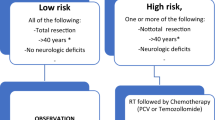Abstract
The study aim to demonstrate the therapeutic tissue depth of photodynamic therapy (PDT) using the photosensitizer talaporfin sodium and semiconductor laser for malignant glioma from an autopsy finding. Three patients diagnosed with glioblastoma by pre-operative imaging (1 newly diagnosed patient and 2 patients with recurrence) were treated with intra-operative additional PDT and adjuvant therapy such as post-operative radiotherapy or chemotherapy. All three patients died of brain stem dysfunction owing to cerebrospinal fluid dissemination or direct invasion of the tumor cells from 13, 18, or 20 months after PDT. Antemortem magnetic resonance images demonstrated no tumor recurrence in the site of PDT, and autopsy was performed for the pathological analysis. Macroscopic observation demonstrated no tumor recurrence in two patients, but one patient demonstrated tumor recurrence in the therapeutic depth of PDT. Microscopic analysis demonstrated histopathological changes reaching depths of 9, 11, and 18 mm (mean: 12.7 mm) from the surface of the cavity of tumor resection, suggesting the therapeutic tissue depth of PDT to be in this range. This region demonstrated glial scarring with infiltration of T lymphocytes and macrophages, with slight degeneration of small vessel walls. However, viable tumor tissues were observed beyond or around the therapeutic tissue depth of PDT in two patients. PDT for glioblastoma prevented early local recurrence, which suggests the possibility that activation of the immune mechanisms was involved. The therapeutic tissue depth was suggested to be 9–18 mm from the surface of the cavity of tumor resection; however, the viable tumor tissues were demonstrated beyond this therapeutic range.






Similar content being viewed by others

References
Akimoto J (2016) Photodynamic therapy for malignant brain tumors. Neurol Med Chir (Tokyo) 56:151–157
Muragaki Y, Akimoto J, Maruyama T et al (2013) Phase II clinical study on intraoperative photodynamic therapy with talaporfin sodium and semiconductor laser in patients with malignant brain tumors. J Neurosurg 119:845–852
Iuchi T, Sugiyama T, Ohira M et al (2018) Clinical significance of the 2016 WHO classification in Japanese patients with gliomas. Brain Tumor Pathol 35:71–80
Akagi Y, Yoshimoto K, Hata N et al (2018) Reclassification of 400 consecutive glioma cases based on the revised 2016 WHO classification. Brain Tumor Pathol 35:81–89
Toussaint M, Pinel S, Auger F et al (2017) Proton MR spectroscopy and diffusion MR imaging monitoring to predict tumor response to interstitial photodynamic therapy for glioblastoma. Theranostics 7(2):436–451
Ikuta S, Kawase Y, Muragaki Y et al (2015) Penetration depth of the 664-nm semiconductor laser light with talaporfin sodium into human brain tissue with glioma. Photodiagn Photodyn Ther 12(3):349
Tsutsumi M, Miki Y, Akimoto J et al (2013) Photodynamic therapy with talaporfin sodium induces dose-dependent apoptotic cell death in human glioma cell lines. Photodiagn Photodyn Ther 10:103–110
Miki Y, Akimoto J, Moritake K et al (2015) Photodynamic therapy using talaporfin sodium induces concentration-dependent programed necroptosis in human glioblastoma T98G cells. Lasers Med Sci 30:1739–1745
Castano AP, Mroz P, Hamblin MR (2006) Photodynamic therapy and anti-tumor immunity. Nat Rev Cancer 6(7):535–545
Korbelik M (1996) Induction of tumor immunity by photodynamic therapy. J Clin Laser Med Surg 14(5):329–334
Nitta M, Muragaki Y, Maruyama T et al (2018) Role of photodynamic therapy using talaporfin sodium and a semiconductor laser in patients with newly diagnosed glioblastoma. J Neurosurg (2018). https://doi.org/10.3171/2018.7.JNS18422
Acknowledgements
The authors are indebted to Helena Akiko Popiel, Department of International Medical Communications of Tokyo Medical University for her review of the English manuscript.
Author information
Authors and Affiliations
Corresponding author
Ethics declarations
Conflict of interest
The authors declare that they have no conflict of interest.
Additional information
Publisher's Note
Springer Nature remains neutral with regard to jurisdictional claims in published maps and institutional affiliations.
Rights and permissions
About this article
Cite this article
Akimoto, J., Fukami, S., Suda, T. et al. First autopsy analysis of the efficacy of intra-operative additional photodynamic therapy for patients with glioblastoma. Brain Tumor Pathol 36, 144–151 (2019). https://doi.org/10.1007/s10014-019-00351-0
Received:
Accepted:
Published:
Issue Date:
DOI: https://doi.org/10.1007/s10014-019-00351-0



